Attached files
| file | filename |
|---|---|
| 8-K - 8-K - PALISADE BIO, INC. | v434338_8k.htm |
Exhibit 99.01

March 15, 2016 28 th Annual Roth Conference
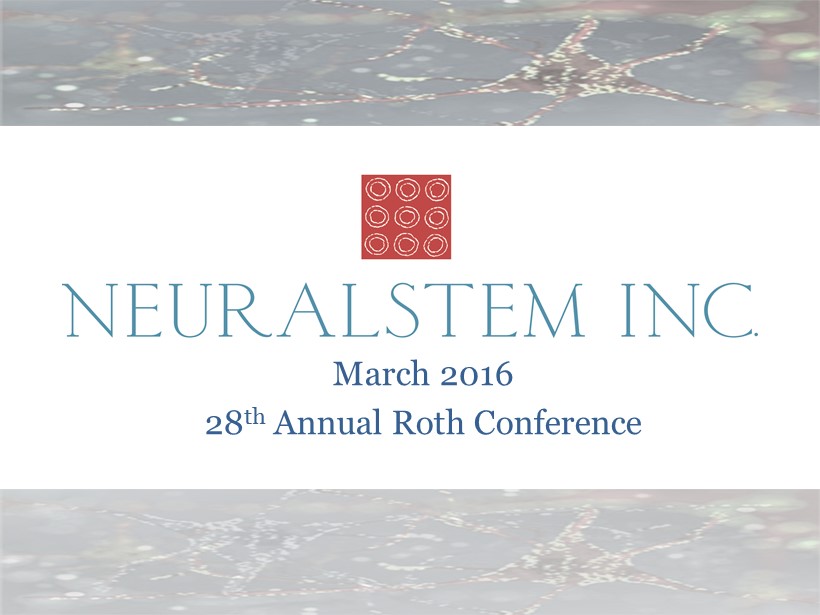
March 2016 28 th Annual Roth Conference

NEURALSTEM, INC. Safe Harbor Statement Safe Harbor statements under the Private Securities Litigation Reform Act of 1995 : This presentation contains forward - looking statements as defined in Section 27 A of the Securities Act of 1933 as amended, and section 21 E of the Securities Exchange Act of 1934 , as amended . Such forward - looking statements are based upon Neuralstem , Inc . ’s management’s current expectations, estimates, beliefs, assumptions, and projections about Neuralstem’s business and industry . Words such as “anticipates,” “expects,” “intends,” “plans,” “predicts,” “believes,” “seeks,” “estimates,” “may,” “will,” “should,” “would,” “potential,” “continue,” and variations of these words (or negatives of these words) or similar expressions, are intended to identify forward - looking statements . In addition, any statements that refer to expectations, projections, or other characterizations of future events or circumstances, including any underlying assumptions, are forward - looking statements . These forward - looking statements are not guarantees of future performance and are subject to certain risks, uncertainties, and assumptions that are difficult to predict . Therefore, our actual results could differ materially and adversely from those expressed in any forward - looking statements as a result of various risk factors . These risks and uncertainties include the risks associated with the effect of changing economic conditions, trends in the products markets, variations in Neuralstem’s cash flow, market acceptance risks, technical development risks and other risk factors detailed in Neuralstem’s Securities and Exchange Commission filings . For links to SEC documents please visit the company’s Web site : neuralstem . com . For links to SEC documents please visit the company’s Web site : neuralstem . com .

Proprietary Neural Stem Cell Technology 3 Neural Stem cell CNS platform Small Molecule Screening Safe, Novel MOA Multiple Targets New Chemical Entity Cell Therapy High unmet medical need Outsourced Funding/Partnering Lead Candidate: NSI - 189 Phase II MDD Lead Candidate: NSI - 566 ALS (orphan), Stroke, cSCI
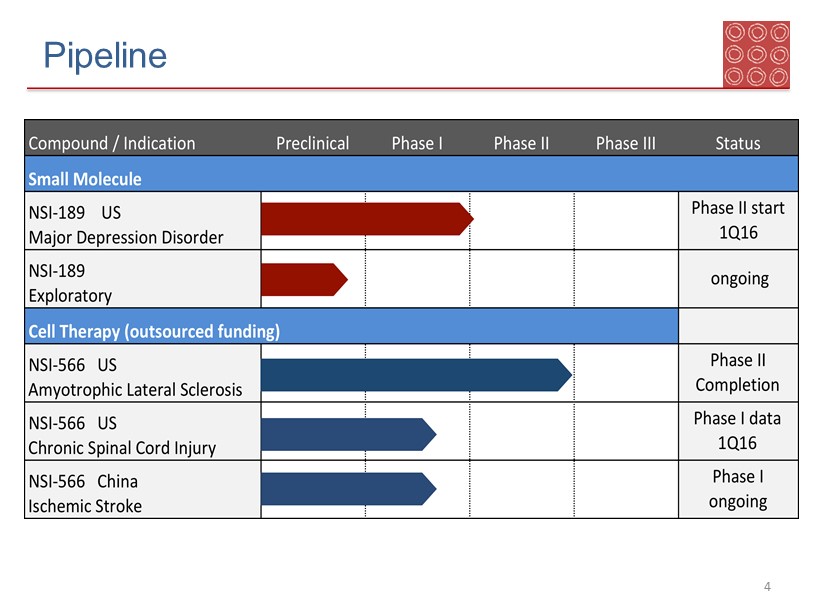
Pipeline 4

Clinical Corporate Goals 5 • MDD Ph II Trial, Data 2H 2017 • Exploration of additional safety studies NSI - 189 • Partnerships for continuing clinical development • Expedite regulatory pathways NSI - 566 • Expansion of clinical & regulatory personnel • Business development initiatives Corporate

NSI - 189 Scientific Advisory Board 6 Dr. Maurizio Fava Harvard, MGH, Executive Vice Chair, Dept. of Psychiatry Principal Investigator: NSI - 189 Phase 2 MDD clinical trial Dr. Michael Thase Univ. of Pennsylvania, Chief. Division of Mood and Anxiety Disorders Treatment and Research Program Dr. Mark Frye Mayo Clinic, Chair, Psychiatry and Psychology Dr. John Greden Univ. of Michigan , Founder and Executive Director, Healthy System Depression Center Dr. Richard Keefe Duke Institute for Brain Sciences, Director Schizophrenia Research Group Dr. Thomas Laughren Harvard, MGH, Director, Regulatory Affairs, Former Director of Psychiatric Division, CDER, FDA World Class Psychiatric, Clinical and Regulatory Experts

7 10,269 Small Molecule Compounds through High Content Screen 16 Neurogenic Compounds in vitro 7 Orally Active Neurogenic Leads ( 3 Structural Classes) 16 Tested for Acute Toxicity in Mice 15 Tested for Neurogenesis in Healthy, Adult Mice 1 Development Candidate Selected NSI - 189 Screening Path to NSI - 189 4 Leads Tested in 3 Mouse Depression Models

NSI - 189 Target Product Profile 8 Indication Monotherapy and Adjunctive treatment of Major Depressive Disorder (MDD), with improvement of cognition Efficacy • Primary: MADRS • Key secondary: Onset of effect, s ustained effect, cognitive symptom improvement Superiority vs. active comparator at day 28 and sustained for 90 days & post - dosing durability Tolerability • Based on clinical wellness • Safe and well tolerated • No major adverse events Safety: • Warnings & Precautions Standard suicidality warning Administration Oral, 4 - 12 weeks episodic course of treatment Health Outc ome Measures (Payer requirement) • Economic modelling for reduced cost to payer • Patient reported outcomes - reduction in symptoms of depression, durability, and cognitive improvement

Cohort 1 N=8 (6 drug, 2 placebo) 40 mg QD Cohort 2 N=8 (6 drug, 2 placebo) 40 mg BID Cohort 3 N=8 (6 drug, 2 placebo) 40 mg TID Acute treatment: 28 days Follow up: Days 35, 42, 49, 56, 70, 84 (End - of - study) Clinical Results from NSI - 189 Phase Ib NSI - 189 Phase Ib double - blind, randomized, placebo - controlled, multiple - dose study assessing safety and tolerability 8
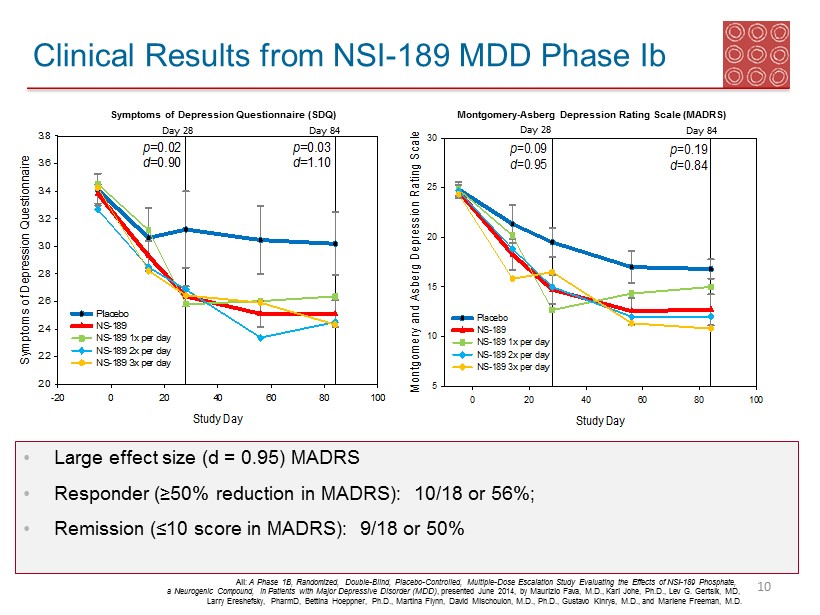
Clinical Results from NSI - 189 MDD Phase Ib 10 p=0.02 d=0.90 Study Day -20 0 20 40 60 80 100 Symptoms of Depression Questionnaire 2.0 2.2 2.4 2.6 2.8 3.0 3.2 3.4 3.6 3.8 Placebo NS-189 NS-189 1x per day NS-189 2x per day NS-189 3x per day p=0.03 d=1.10 Day 84 Day 28 Symptoms of Depression Questionnaire (SDQ) p=0.09 d=0.95 Study Day 0 20 40 60 80 100 Montgomery and Asberg Depression Rating Scale 5 10 15 20 25 30 Placebo NS-189 NS-189 1x per day NS-189 2x per day NS-189 3x per day p=0.19 d=0.84 Montgomery - Asberg Depression Rating Scale (MADRS) Day 28 Day 84 • Large effect size (d = 0.95) MADRS • Responder (≥50% reduction in MADRS): 10/18 or 56%; • Remission ( ≤10 score in MADRS): 9/18 or 50% All: A Phase 1B, Randomized, Double - Blind, Placebo - Controlled, Multiple - Dose Escalation Study Evaluating the Effects of NSI - 189 Phosp hate, a Neurogenic Compound, in Patients with Major Depressive Disorder (MDD) , presented June 2014, by Maurizio Fava, M.D., Karl Johe, Ph.D., Lev G. Gertsik , MD, Larry Ereshefsky , PharmD , Bettina Hoeppner , Ph.D., Martina Flynn, David Mischoulon , M.D., Ph.D., Gustavo Kinrys , M.D., and Marlene Freeman, M.D.

p=0.01 d=0.94 Study Day -20 0 20 40 60 80 100 Cognitive and Physical Functioning Questionnaire 2.0 2.5 3.0 3.5 4.0 4.5 5.0 Placebo NS-189 NS-189 1x per day NS-189 2x per day NS-189 3x per day p<0.01 d=1.20 Day 28 Day 84 Clinical Results from NSI - 189 MDD Phase Ib 11 All: A Phase 1B, Randomized, Double - Blind, Placebo - Controlled, Multiple - Dose Escalation Study Evaluating the Effects of NSI - 189 Phosp hate, a Neurogenic Compound, in Patients with Major Depressive Disorder (MDD) , presented June 2014, by Maurizio Fava, M.D., Karl Johe, Ph.D., Lev G. Gertsik , MD, Larry Ereshefsky , PharmD , Bettina Hoeppner , Ph.D., Martina Flynn, David Mischoulon , M.D., Ph.D., Gustavo Kinrys , M.D., and Marlene Freeman, M.D. • Large effect size (d=0.94) in cognitive function improvement • Persistent improvement over the drug - free 8 weeks in CPFQ Cognitive and Physical Functioning Questionnaire (CPFQ)
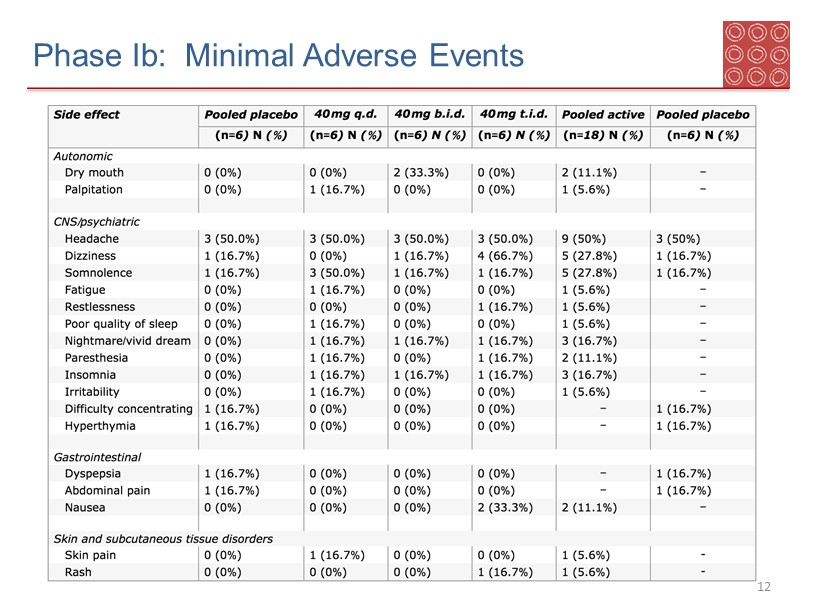
Phase Ib : Minimal Adverse Events 12

Topographs of High Frequency alpha (10 - 12 Hz): Day 28 from Baseline Left posterior temporal (T5) (t=2.45, p=0.02) Left parietal regions (P3) (t=3.31, p=0.004) qEEG Biomarker Results from NSI - 189 MDD Phase Ib Quantitative EEG ( qEEG ) biomarker : • Increases coherence activity between prefrontal cortex and hippocampus • Two coordinating brain centers utilized for depression and cognition A Phase 1B, Randomized, Double - Blind, Placebo - Controlled, Multiple - Dose Escalation Study Evaluating the Effects of NSI - 189 Phosp hate, a Neurogenic Compound, in Patients with Major Depressive Disorder (MDD) , presented June 2014, by Maurizio Fava, M.D., Karl Johe, Ph.D., Lev G. Gertsik , MD, Larry Ereshefsky , PharmD , Bettina Hoeppner , Ph.D., Martina Flynn, David Mischoulon , M.D., Ph.D., Gustavo Kinrys , M.D., and Marlene Freeman, M.D. 13

Biomarker Results from NSI - 189 MDD Phase Ib Blood biomarker panel : • Blood panel analysis correlates to MADRS r esponse rate • MDD panel was developed based on SSRIs activity profile • Rapid and persistent efficacy 14 Response Rate Partial Responder (<14) +Responders ( ≥ 50%) Responder ( ≥ 50%) Remission ( ≤ 10) By MADRS 13/ 18 ( 72% ) 10/18 (56%) 9/18 (50%) By Blood Panel 13/ 18 ( 72% ) • A1AT • ApoC3 • BDNF • Cortisol • EGF • MPO • Prolactin • Resistin • TNFR2 • TSH Biomarker Profiling of NSI - 189 Phosphate, a Neurogenic Compound, in Patients with Major Depressive Disorder (MDD) during a Phase Ib Randomized Double - Blind, Placebo - Controlled Trial JA . Bilello1, X. Feng1, LM.Thurmond1 , L. Gertsik2, BA. English3, L. Ereshefsky3, M. Fava4, B. Hoeppner4, M. Flynn4, D. Mischou lon 4, G. Kinrys4, M. Freeman4, and K. Johe5 10 Biomarker:

NSI - 189 Phase II MDD Trial 15 Milestones: • First Patient enrolled 2Q16 • Phase 2 Data 2H17 Study Objectives • Primary: Montgomery - Asberg Depression Rating Scale (MADRS ) • Secondary: SDQ , HAMD17, CGI - S, CPFQ, SFI, Cogscreen Battery, Cogstate Brief Battery Principal Investigator: Maurizio Fava, M.D. Slater Family Professor of Psychiatry at Harvard Medical School, Massachusetts General Hospital Randomized, Double - Blind, Placebo - Controlled, 2 - Dose Study

NSI - 189 Phase II MDD Trial 16 • Three arm: 40mg BID, 40mg QD, & placebo (n=220 randomized ) • H igher quality MDD trial sites (n=12 ) • Independent , remote, confirmation of MADRS diagnosis by MGH • P lacebo - reducing prescreen process • Potential registration study if successful in either active arm • Power: >80%, 2 - sid ed p ≤ 0.05; d=0.5 Innovative Study Design

Building the Case for MOA 17 No appreciable binding activity against 52 neurotransmitter related receptors/ion channels/ enzymes No binding or functional activities against 900 Other kinases (DISCOVERX KinomeScan ) NSI - 189 Binding Activities ≥ 50% at 10µM Target IC50 (µM) Dopamine Transporter (h) 14.2 Norepinephrine Transporter (h) 1.1 5 - HT Transporter (h) >30 5 - HT3 Receptor 2.1 5 - HT7 Receptor (h) 11.1 Opioid mu Receptor (h) 15.7 Opioid delta 1 Receptor 12.7
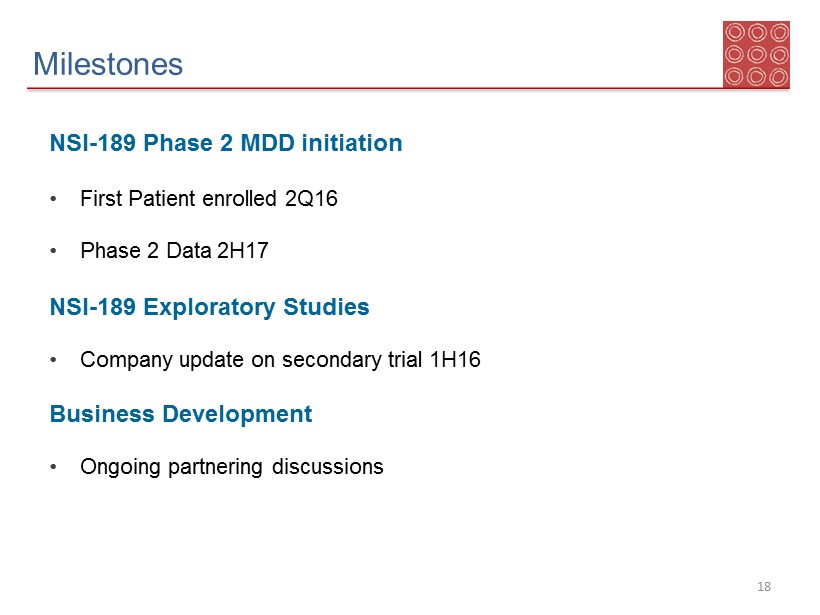
18 Milestones NSI - 189 Phase 2 MDD initiation • First Patient enrolled 2Q16 • Phase 2 Data 2H17 NSI - 189 Exploratory Studies • Company update on secondary trial 1H16 Business Development • Ongoing partnering discussions
